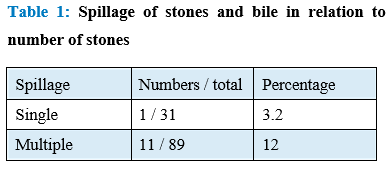Abstract
Introduction: Laparoscopic cholecystectomy is the choice of operation
for symptomatic gallstones. Gallstone and bile spillage can occur during
laparoscopic cholecystectomy during dissection by cautery or due to
perforation of gall bladder by grasper. The complication of spilt stone and
bile may range from simple superficial surgical site infection, adhesion,
obstruction, abscess formation to none.
Methods: This study was conducted
at Western Regional Hospital (WRH), Pokhara from July 2015 to December
2016. A total of one hundred and twenty patients who underwent laparoscopic
cholecystectomy were included. All patients’ age, sex, pre-operative
ultrasound findings, intra operative spillage of stone and bile and post-
operative superficial surgical site infection were noted. Statistical analysis
was done using Microsoft Excel software and SPSS-21. Result obtained
from the study was discussed with reference to current world literature.
Results: Out of one hundred and twenty patients, one hundred and nine
were female and eleven were male with mean age of 42.68 years. Spillage
of stones and bile occurred in twelve patients (10%). Spillage of stone and
bile was common with multiple stones. Only four patients (one male and
three females) developed superficial port site infection (3.3%). Two patients
among spillage and two among non spillage developed superficial surgical
site infection (p<0.05). Most common organism was Staphylococcus aureus
followed by Escherichia coli.
Conclusion: The incidence of split stone or bile
is 10 % and is common with multiple gallstones. The chance of superficial
surgical site infection is more in male patients and with spillage of stone and
bile.
References
Am J Surg.1993 Apr;165(4):497–504.
2. Memon MA, Deeik RK, Maffi TR. The outcome of unretrieved gallstones in the peritoneal cavity during laparoscopic cholecystectomy. A prospective analysis. Surg Endosc.1999
Sep;13(9):848–857.
3. Yerdel MA, Alacayir I, Malkoc U, Baba F, Erverdi N, Pak I et al. The fate of intraperitoneally retained gallstones with different morphologic and microbiologic characteristics: an experimental study. J Laparoendosc Adv Surg Tech A.1997 Apr;7(2):87–94.
4. Welch N, Hinder R. Laparoscopic capture of escaped gallstones.
Surg Lap Endosc.1991 Mar;1(1):42–44.
5. Shindholimath, AA, Seenu V, Parshad R, Chaudhry R, Kumar
A. Factors influencing wound infection following laparoscopic cholecystectomy. Tropical Gastroenterology.2002;24(2): 90-92.
6. Jan WA, Ali SI, Shah NA, Ghani A, Khan M, Khan AS .The frequency of port-site infection in laparoscopic cholecystectomies. Journal of Postgraduate Medical Institute.2011 Jan; 22(1):66-70.
7. Woodfield JC, Rodgers M, Windsor JA. Peritoneal gallstones
following laparoscopic cholecystectomy: incidence, complications, and management. Surg Endosc.2004 Aug;
18(8):1200 –1207.
8. Sathesh-Kumar T, Saklani A, Vinayagam R, Blackett R. Spilled gall stones during laparoscopic cholecystectomy: a review of the literature. Postgraduate Medical Journal.2004 Feb;80(940):77-79.
9. Brockmann JG, Kocher T, Senninger NJ, Schürmann GM. Complications due to gallstones lost during laparoscopic cholecystectomy. Surgical Endoscopy.2002 Aug; 16(8):1226-
1232.
10. Hui TT, Giurgiu DI, Margulies DR, Takagi S, Iida A, Phillips EH. Iatrogenic gallbladder perforation during laparoscopic cholecystectomy: etiology and sequelae. Am Surg. 1999 Oct;
65(10):944 –948.
11. Saud JD, Abu Al-Hail MC. Surgical site infection after laparoscopic cholecystectomy. Basrah Journal of Surgery.2010 Mar; 16(2): 119-121.
12. Al-Naser KH. Port site infection after laparoscopic cholecystectomy. Int J Med Res Health Science.2017; 6(6):132-137.
13. Zehetner J, Shamyeh A, Wayand W. Lost gallstones in laparoscopic cholecystectomy: All possible complications. Am J surgery. 2007 Jan; 193(1):73-78.
14. Zinner MJ, Ashley SW. Maingot’s abdominal operations.12th ed.
New York. McGraw-Hill Publications, 2013. p 1014-1088.
15. Schafer M, Suter C, Klaiber C, Wehrli H, Frei E, Kra¨henbu¨h lL. Spilled gallstones after laparoscopic cholecystectomy. A relevant
Incidence of Superficial Port Site Infection - Paudel et al.
problem? A retrospective analysis of 10,174 laparoscopic
cholecystectomies. Surg Endosc.1998 Apr; 12(4):305–309.
16. Tumer AR, Yu¨ksek YN, Yasti AC, Go¨zalan U, Kama NA. Dropped gallstones during laparoscopic cholecystectomy: The consequences. World J Surg.2005 Apr; 29(4):437– 440.
17. Horton M, Florence MG. Unusual abscess patterns following dropped gallstones during laparoscopic cholecystectomy. Am J
Surg. 1998 May;175(5):375–378.
18. Rioux M, Asselin A, Gregoire R, Dallaire C. Delayed peritoneal and retroperitoneal abscesses caused by spilled gallstones: A complication following laparoscopic cholecystectomy. Abdom
Imaging. 1995 Apr;20(3):219 –221.
19. Lutken W, Berggren P, Maltbaek J. Passage of gallstone via the urethra: a complication of laparoscopic cholecystectomy. Surg
Laparosc Endosc. 1991 Dec;1(2):246 –247.
20. Yamamuro M, Okamoto B, Owens B. Unusual presentations of spilled gallstones. Surg Endosc. 2003 Sep;17(9):1498.
21. Sharma AK , Sharma R, Sharma S. Port site infection in laparoscopic surgeries- Clinical study. Indian Medical Gazette. 2013 Jun;147(6);224-229.

